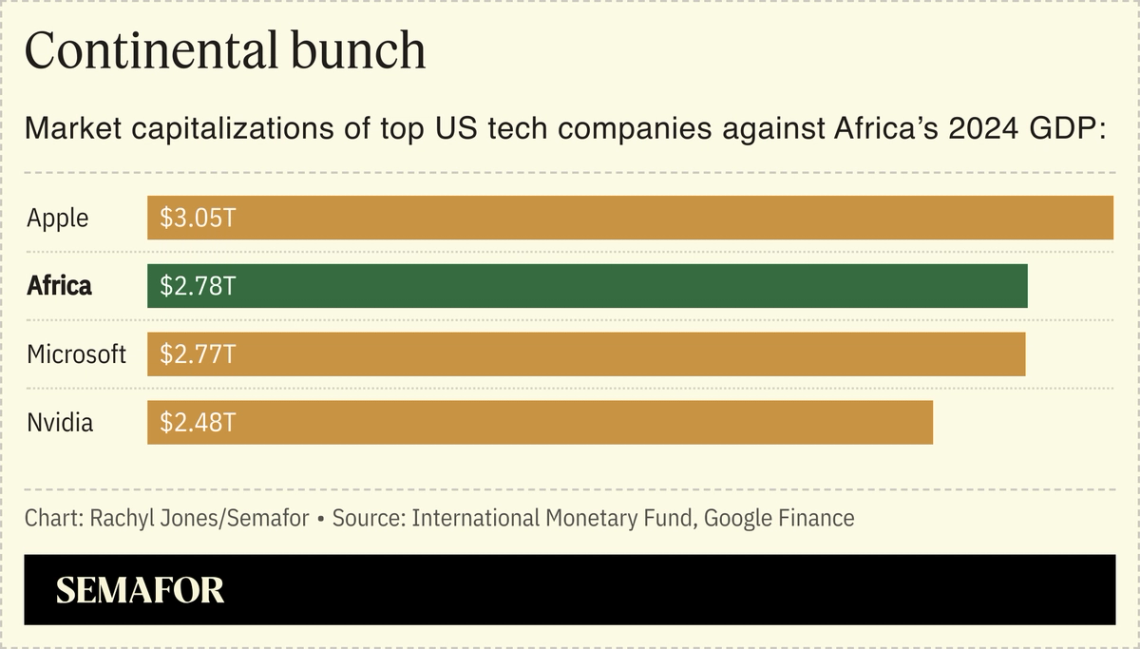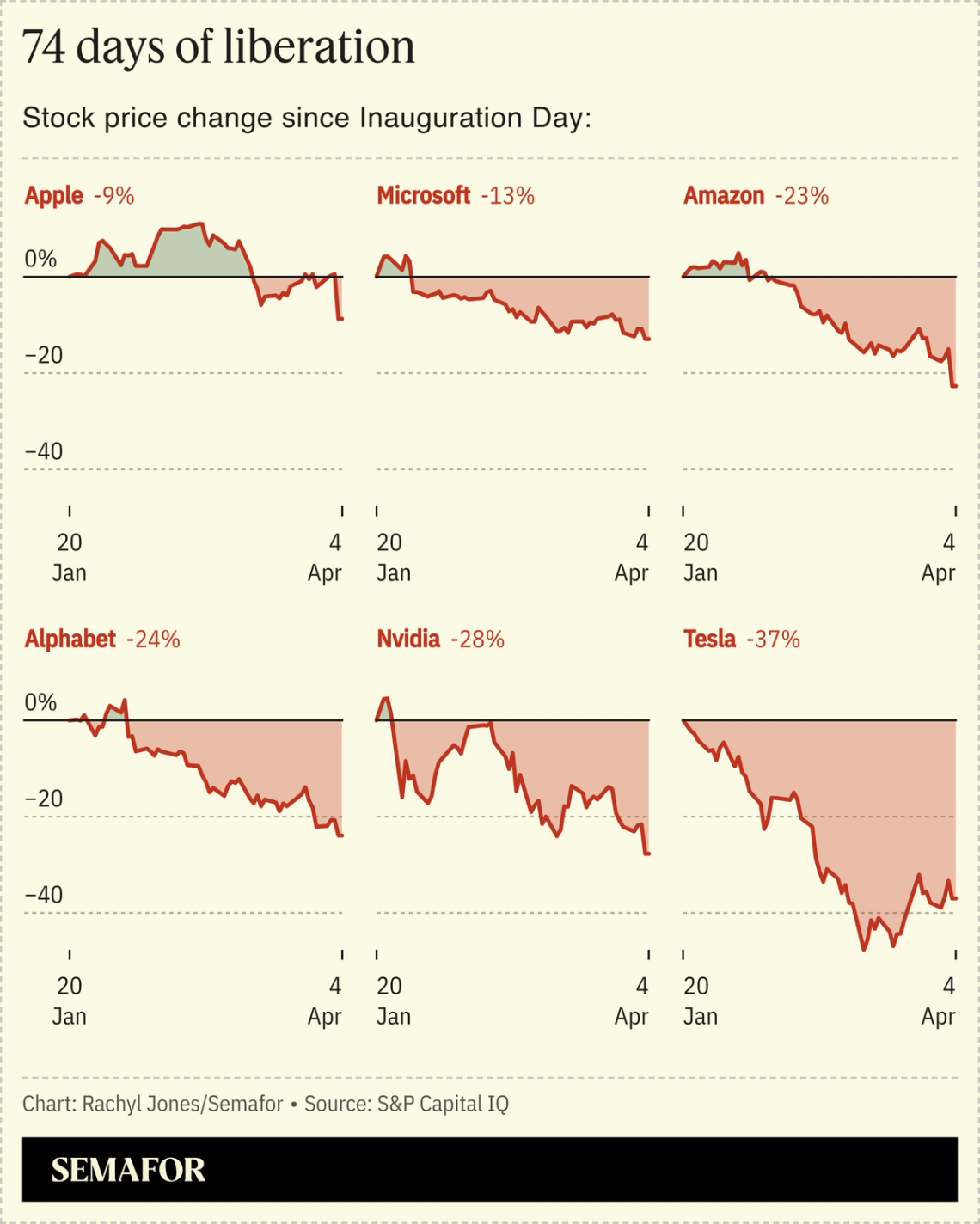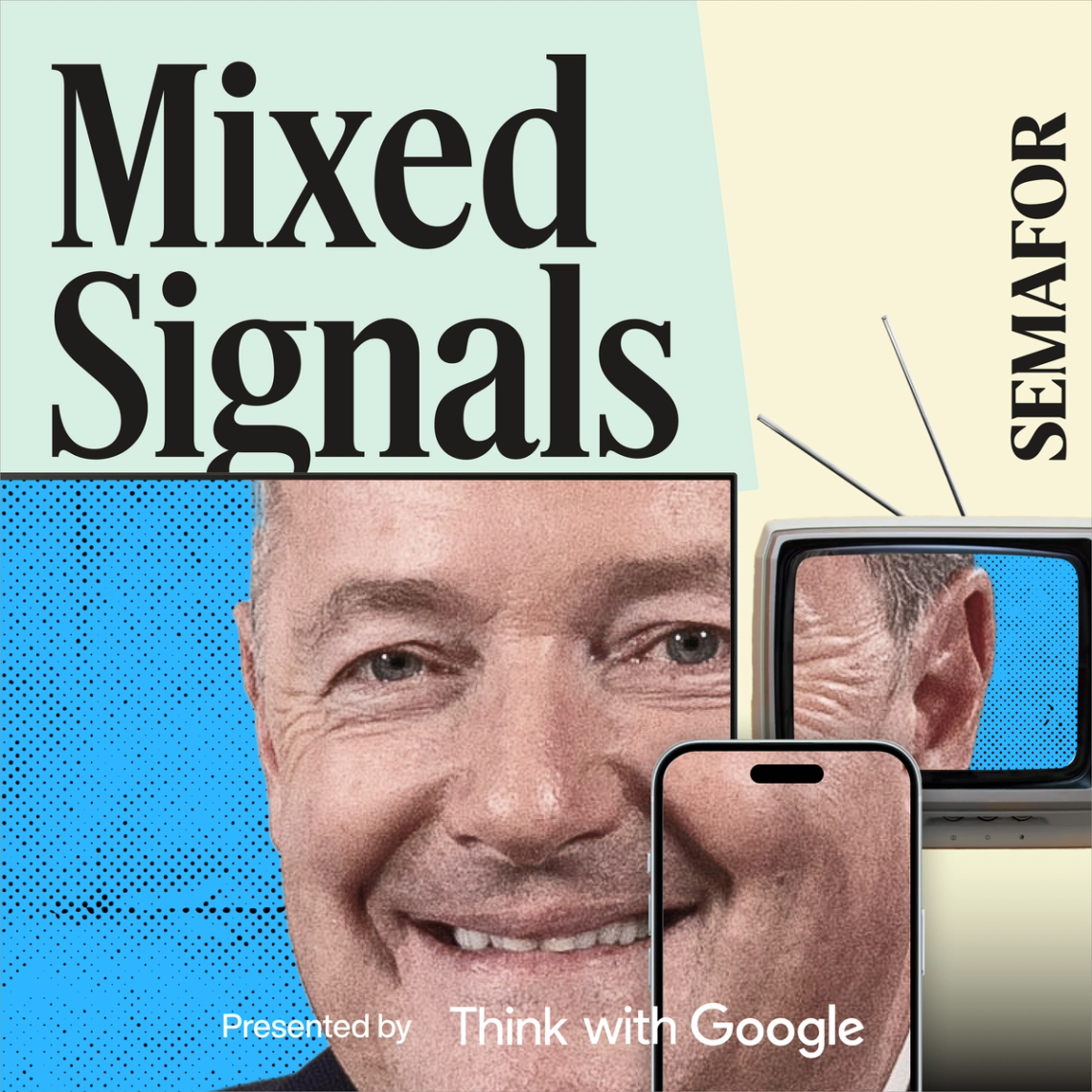| In this edition, why tech shouldn’t hit the panic button on Trump’s tariffs (yet), and Google’s unca͏ ͏ ͏ ͏ ͏ ͏ |
 | Reed Albergotti |
|
Hi, and welcome back to Semafor Tech.
In the wake of “Liberation Day,” the question for the tech industry is whether President Donald Trump is really willing to torpedo one of the country’s best defenses against foreign adversaries — and a big driver of the economy.
As my Net Zero colleague Tim McDonnell pointed out, the energy tariffs alone could cripple the country’s ability to compete in AI (you can sign up for Tim’s newsletter here). But energy is only one part of that tech stack. The tariffs would affect practically all of it. Though the high-priced Taiwan-made AI processors are exempt, the components around them may be taxed, and it’s unclear what happens when those chips get added to larger devices and products in other countries and then shipped back to the US.
The Trump administration, which once promised a “Manhattan Project for AI,” would then be handing victory to China while hampering an economic engine for the United States.
But there’s some evidence it’s all for show. During Trump’s first term, he made a big deal about tariffs and then made exceptions for key companies in the tech industry. Apple, for instance, was able to get special treatment, allowing them to avoid massive price increases. And CEO Tim Cook got a prime spot during the president’s inauguration in January.
There are murmurs that the administration already has deals in place that it is waiting to announce later, so that it can claim a big victory on its tariff policy. That has made some in the tech industry hopeful.
Those deals don’t have to be particularly substantive or new. For instance, Trump recently held a White House event touting OpenAI’s $500 billion “Stargate” compute cluster in Texas. But that was underway long before the November election and the announcement was just a non-binding promise to put even more money into the project.
Despite the devastating impact the tariffs are having on the United States as a whole, it may be too early for the tech industry to hit the panic button.
➚ MOVE FAST: No pain. On Thursday, Trump said he would consider tariff relief on Chinese imports if Beijing approves the sale of TikTok’s US business, Reuters reported. The administration must secure a deal or extend the deadline by Saturday, or US consumers will once again lose access to the social media platform. ➘ BREAK THINGS: No gain. AI has the potential to increase inequality between nations, with 40% of corporate research and development spending concentrated among 100 firms mainly located in the US and China, the United Nations said in a report Thursday. Such technical divides risk developing nations missing out. The market caps for top US firms rival the gross domestic product of the entire African continent.  |
|
Every major tech company has lost value since “Liberation Day,” but the slide for most companies really goes back to Inauguration Day, when the Trump administration’s policies began flatlining the economy.  |
|
 Brian Hansen/Flickr. CC BY-NC-SA 2.0. Brian Hansen/Flickr. CC BY-NC-SA 2.0.Diamonds are a programmer’s best friend. DeepMind’s Dreamer agent hit a new benchmark in an unusual test: the ability to collect virtual diamonds in the popular video game Minecraft without prior training, Nature reported. The feat represents a significant advancement in AI’s ability to imagine future scenarios and predict the effects of actions. In the game, players acquire diamonds — which they use to build tools and weapons — through a roughly 10-step process that includes gathering materials to build multiple pickaxes for gradually hardening terrains. In the past, OpenAI researchers trained a neural network to collect diamonds by showing videos of humans playing, but this is the first time an AI system has done so with no prior knowledge of the necessary steps. It used reinforcement learning, a trial-and-error process, to guide its decision-making, allowing it to “understand its physical environment and also to self-improve over time, without a human having to tell it exactly what to do,” a DeepMind computer scientist told Nature. Such findings can be applied to advanced robotics, where bots must complete multi-step tasks in the real world and weigh the potential risks and rewards of actions before taking them. |
|
 Since the 80s, Piers Morgan has ridden massive changes in the media industry, jumping from print to cable to, more recently, YouTube. This week on Mixed Signals, the TV star joins Ben and (subbing in for Max) Semafor’s head of comms, Meera Pattni, to discuss how he’s building his Uncensored brand, what he likes about being a YouTuber, and if he misses anything about legacy media. They also talk about how some journalists take themselves too seriously, why having fun is important even in news media, and his views on Trump’s term so far. Listen to the latest episode of Mixed Signals now. |
|
 The amount Chinese firms including ByteDance, Alibaba, and Tencent have spent on Nvidia’s H20 chips since the start of the year, The Information reported. The rushed orders were prompted by reports that the Trump administration might consider banning the sale of H20 chips to China. Nvidia’s more advanced Blackwell chips have similar restrictions. |
|
It’s a good time to be a Google alum. Ex-Google employees lead a significant share of the top AI startups — a dozen of which have raised $23 billion with a combined valuation of $92 billion, according to the latest PitchBook figures. The trend underscores Google’s wide-reaching impact, not just with its own AI research and products, but by creating an environment that’s like an incubator for AI talent. Other tech giants produce successful alumni with prominent companies, but they don’t have the same startup market saturation as Google.  Kimberly White/Getty Images for TechCrunch. CC BY 2.0. Kimberly White/Getty Images for TechCrunch. CC BY 2.0.Dario Amodei’s Anthropic holds the biggest slice of the startups’ combined valuation, representing two-thirds of the $92 billion market capitalization — followed by Perplexity, Mistral AI, and Cohere. Even further down the list, Google alums still boast billion-dollar companies with some of the most prominent investors in the game. Arvind Jain, who spent more than a decade at Google, is now the CEO of Glean, an AI work platform with a $4.6 billion valuation. Ping Wu, former senior engineering director at Google, runs the Andreessen Horowitz-backed AI-powered call center Cresta, worth $785 million, according to PitchBook. Also noteworthy: Three of the ex-Googlers spent time at OpenAI before founding their own ventures. |
|
  Stringer/Reuters Stringer/ReutersSweeping global tariffs announced by President Trump this week will significantly raise the costs of renewable energy, making it harder for major US tech companies to meet their data center energy needs, Semafor’s Tim McDonnell writes. Higher costs will be passed on to energy consumers at a moment when, as NextEra Energy CEO John Ketchum recently told Semafor, renewables are still the cheapest and most readily available solution to the looming US power deficit. Tariffs on critical minerals, steel, aluminum, and components for power transformers will also make energy projects of all kinds more expensive. |
|









